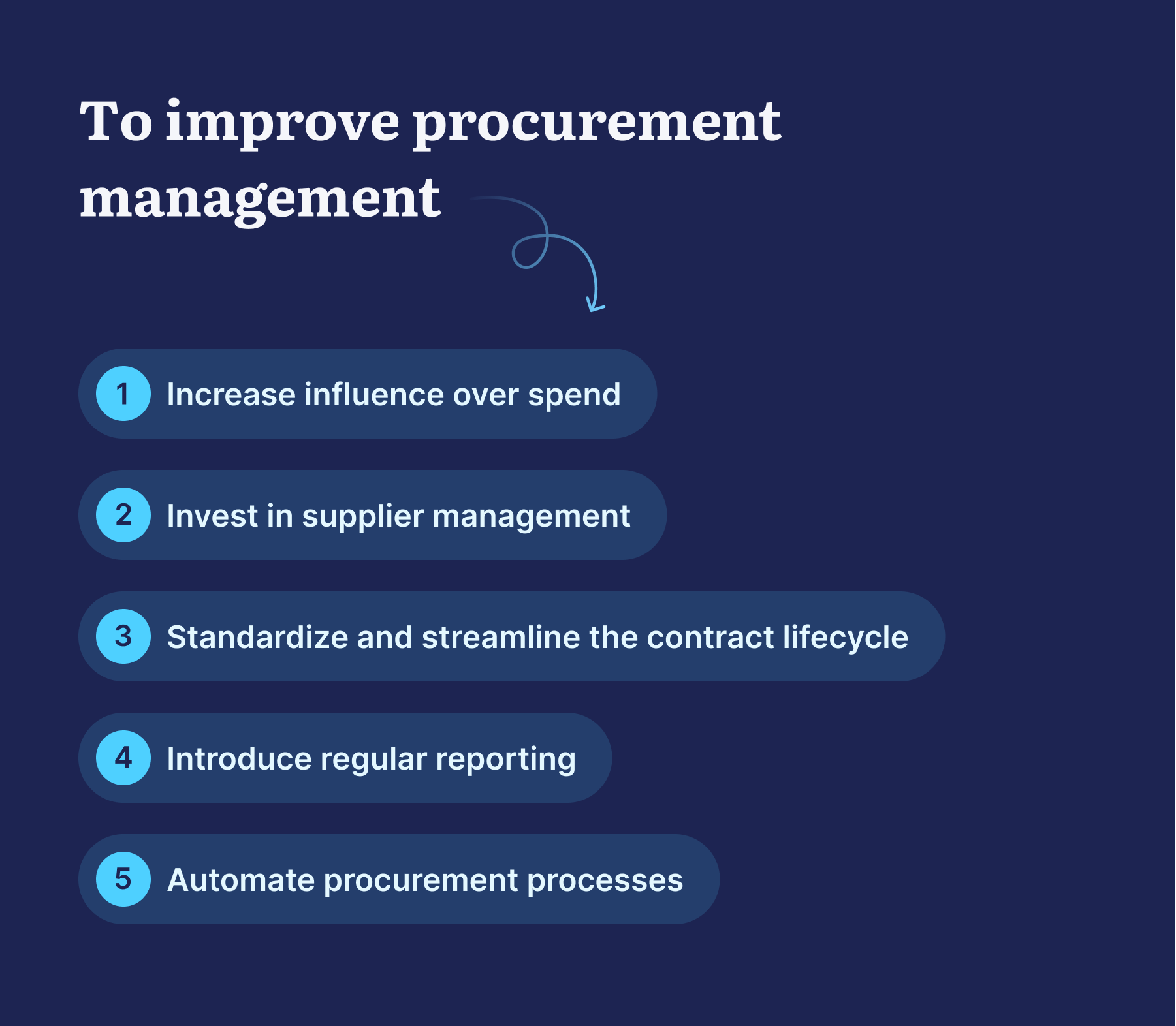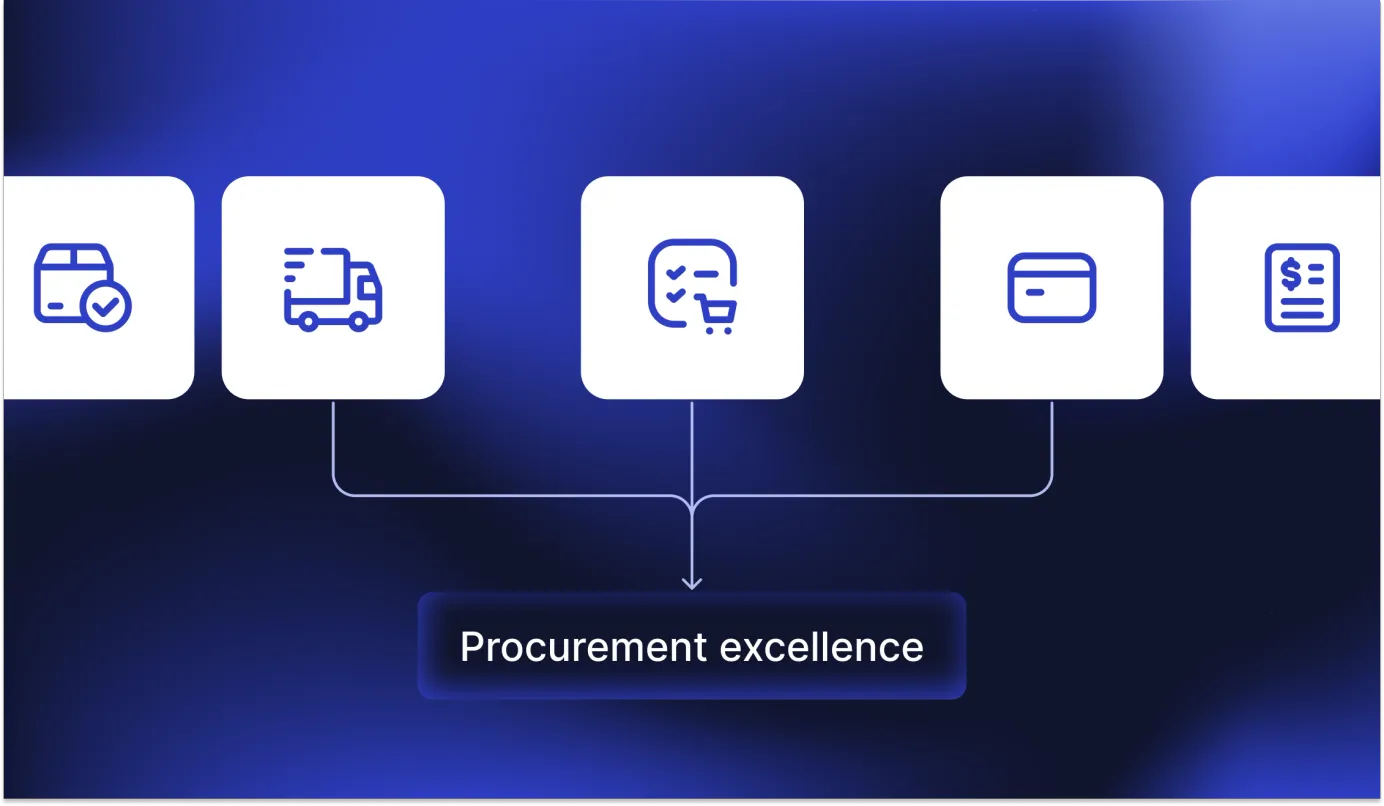
10 min read
The Basics of the Procurement Management
Procurement is an undeniably important component of any company's operations, but it's often done intuitively and manually.
For some businesses – usually smaller or with a single-source purchasing flow – it may be sustainable to react to the immediate needs. However, growing organizations that face increasing complexity recognize the value of thoughtfully-planned and managed procurement.
It pays off to develop a procurement strategy, hire a team of professionals, and acquire necessary technologies early on. Being prepared allows for efficient and timely execution of procurement functions.
Read to discover more:
- What is procurement management
- Benefits of implementing procurement strategy
- Three pillars of procurement management
- Fundamentals of successful procurement management
- Procurement management process
- Challenges in managing procurement
- Ways to improve procurement management
- Why digitizing procurement management is a good idea
What is Procurement Management
Procurement is a process of acquiring goods and services that the company needs for operating.
Procurement activities and needs vary based on the company's structure and business goals, but three main types of procurement are applicable universally.
- Direct procurement is about buying anything needed to manufacture a product. It can be raw materials or constituent components, for example.
- Indirect procurement deals with purchasing items to support the daily running of the company. These goods are not relevant directly for manufacturing but rather for supporting operations. Office supplies would be an example of indirect procurement. Read more about direct vs. indirect spend here.
- Services procurement includes sourcing services provided by people – consultancy, for instance.
No matter your organization's procurement process, you aim to have the highest ROI and predictability in procuring items and services. That's why a strategic outlook on handling procurement operations is always recommended.
Procurement management is the strategic approach to building this organized procurement process. Its goal is to enable acquiring high-quality goods and services from approved vendors and suppliers within a defined budget and in time.
Managing procurement means overseeing key processes such as sourcing, requisitioning, ordering, expediting, inspecting, and reconciliation. Because encompassing all steps of purchasing cycle, it's also called the source-to-settle process.
While smaller organizations can have just one person handling procurement operations, larger businesses may have a whole procurement department. However, the procurement process isn't limited to just purchasing professionals; it involves employees across various departments and stakeholders.
A procurement manager must consider and balance the needs of multiple departments, facilitate clear communication and evaluate whether requests support the company's business objectives.
Benefits of Implementing Procurement Management Strategy
It's possible to deal with procurement on the go and react to the potential issues as they arise. However, it's quite a short-sighted approach that's not sustainable in the long run.
On the other hand, strategic procurement management has undeniable benefits.
Cost control
Purchasing cost is the primary concern of most businesses. Professional procurement manager focuses on optimizing organizational spending and ensuring staying within budget. He finds and negotiates the best deals, aims to streamline workflows and eliminate unnecessary spending.
Quality
When procurement processes are well managed, the business has the space and time to conduct proper market research, find goods and services of satisfying quality, and negotiate good deals with the suppliers.
Certainty
Procurement management ensures realistic and data-based planning for future spending. A good manager can also guarantee sourcing security by introducing guidelines and tools for managing supplier relationships.
Planning offers certainty regarding the company's future and increases stakeholders' confidence.
Reduced risk
When the procurement teams follow the plan and commonly accepted internal practices, it's easier to predict any potential risks and minimize their potential impact. Developing risk-management strategies is also a part of procurement management.
Three Pillars of Procurement Management
There are three pillars of procurement management strategy: process, people, and paperwork. It's important to consider all three.
A thought-out process is the core of the management strategy. To ensure time and money are invested in the most efficient way and business goals are met with no wasted resources, procurement professionals develop detailed step-by-step workflows.
They also utilize procurement management tools to streamline processes and centralize databases, documents, and financials but fragmentize responsibilities.
But creating perfect workflows isn't enough. Then come the people. It's crucial to assemble a team of professionals who would put their best efforts into bringing the designed procurement strategy to life.
Whether we're talking about a large procurement department or a few employees, ensuring everyone involved is qualified and aligned is important. Roles, responsibilities, and permissions should be clearly defined, presented in writing, and mutually agreed upon.
Every procurement operation then has to be reflected in the paperwork. As evidence of the transaction details, it must be maintained properly for future reporting and eventual disputes.
Businesses have been swiftly shifting from the actual "paper"-work to online solutions for information safety and automatic processing. But the principle stays the same – documentation is important.
Fundamentals of Managing Procurement Successfully
Well-managed procurement is important in every industry to ensure continuous business development. But to maximize the efficiency of procurement management, it's essential to tailor the system to the needs of a particular organization.
Purchasing Portfolio
Understanding purchasing portfolio is fundamental for developing a successful purchasing management strategy. A workwear manufacturing factory and a bakery would comprehend procurement differently.
What are you buying? How often? In what quantities? Do you need to contract vendors or suppliers? Or both? Are storage spaces needed for your purchases? Which type? Is your purchasing seasonal? Do your procurement needs depend on other business partners?
Get as many details about your organization’s procurement needs as possible, and systemize the knowledge.
Inventory Overview
Procurement management is a much broader concept than just controlling the cost and quality of purchased goods and services. It's also about making sure not to waste investments.
Therefore, another factor to consider in the procurement cycle is ensuring that purchased goods are correctly stored and used in time. Procurement management includes maintaining inventory and storage conditions and controlling warehouse expenses.
Risk management
No business operations are without risk, and procurement has its own. The procurement process requires dealing with external parties, and there is absolutely no way to predict and prevent mistakes and malfunctions. And some circumstances are simply out of the manager's control.
Which makes being prepared even more important. Successful procurement management includes plans B, C, and D to anticipate and tackle various challenges. Most frequent ones being:
- Delivery delays
- Inconsistent quality of the goods
- Malfunction of the supplier for a single-source product
- Market price fluctuations
Performance indicators
To design a successful procurement management system, defining “success” first is essential.
While varying from business to business in specifics, key performance indicators are indispensable metrics for measuring progress and efficiency. Checking goods quality, delivery and processing speed, communication efficiency, and other indicators is better with standards in mind.
Creativity and Inspiration across Markets
Thinking outside the box may bring valuable insights. Search for inspiration outside of your business's typical market. There's no promise that someone has ever solved the very exact issue you are facing, but they might have found a helpful approach to searching for the solution.
What's a Procurement Management Process?
Well-developed process defines the success of procurement operations. But what is this process, and how to get it right? Every organization is different, and no process is the same. But there are some milestones to take as a starter and adapt.
1. Identifying the company's internal needs and ensuring they are aligned with the business goals
Determine which products or services the company needs and how they will help to achieve business goals. It can be based on existing projects and immediate needs or as a forecast for future operations.
This step includes specifying the product, establishing a timeframe for getting it, and allocating responsible employees along the purchasing process.
2. Researching, evaluating, and selecting vendors or suppliers
There are several ways to find a suitable vendor or supplier:
- searching through the database of established partnerships,
- researching new vendors and suppliers,
- proactively sending out requests for proposals.
Consider quality-to-price ratio and delivery terms. Depending on the nature of your business, you might need to consider the supplier's flexibility – are they willing to renegotiate terms of cooperation following internal changes in your company or market shifts?
3. Negotiating procurement contracts with the selected vendors or suppliers
Next come negotiations for the best price and delivery terms and the closing of the deal subsequently.
It usually starts with receiving biddings from several suppliers. Parties enter negotiations during which all requirements and expectations should be communicated, agreed upon, and written down. The terms of the contract are then certified legally.
4. Issuing and approving Purchase Requisitions – if relevant
Based on the organization's size, number of departments, and structural specifics, the company's purchasing workflow may include the step of issuing a Purchase Requisition. If employees see the need for the product or service, they can request a purchase in the company’s name.
5. Issuing, approving and sending Purchase Orders
The company's need is communicated to the selected vendor via the Purchase Order. Purchase Order includes product or service specifications, exact price, delivery, and payment terms and must be confirmed by both parties – the buyer and the seller.
6. Invoice approval
Upon confirming the Purchase Order, the seller issues an Invoice. The responsible financial professional should check, confirm, and match it to the accounting system. If needed, changes may be requested.
Based on the contract terms, transactions can be prepaid or postpaid – therefore, Invoice processing might come before or after the delivery.
7. Confirming and auditing delivery
The vendor will deliver the products or services under the contract and Purchase Order terms. The buying side should be prepared to receive a delivery, document and confirm it, and process promptly – so that required products or services are put to use in time.
8. Three-way matching
Purchase needs and accounts payable should be aligned by conducting the three-way match: matching the Purchase Order, the Receiving Document, and the Invoice. If there are any discrepancies, documents are sent back for adjustments.
And if defects are found in the ordered goods or services, a replacement (or other alternative solution) can be requested.
9. Authorizing Payment
When three-way matching is confirmed as successful, the buyer pays the seller, and the purchasing transaction is completed.
10. Maintaining records
Records of the transaction and vendor performance should be archived – for several reasons.
- They might be required for an audit later.
- Transactions can be repeated in the future while re-ordering, and having a previous one as a reference may save a lot of time compared to starting from scratch.
- Procurement data is also invaluable when analyzing processes in place and the procurement team's KPIs.

Challenges in Managing Procurement
Procurement managers can face several important challenges to recognize and deal with to maximize the potential of implemented solutions and workflows.
Lack of transparency
If procurement processes are not transparent and information is ambiguous, it's hard to make informed decisions on time. Not having information instantly available for everyone involved in the procurement can also pose a risk of increased fraudulent behavior.
Process inefficiencies
Without a system in place, tasks and responsibilities are not distributed clearly in the team, and some steps can take excessively long. In addition, if procurement is managed manually, there is a high risk of human error.
Such inefficiencies lead to financial losses – for example, seller's fines for late payments or missed opportunities of early payment discounts. It also causes delays in the supply chain, which can result in significant financial and reputational losses.
Maverick spending
Uncontrolled and unpredicted maverick spending is one of the critical challenges that procurement managers face. It doesn’t follow established procurement policies and is difficult to track and predict.
Ways to Improve Procurement Management
There is always a space for improvement, especially in the fast-paced modern world. To level up your procurement management game, try the following.
Increase influence over spend
To prevent employees from uncontrolled purchasing from suppliers that are not approved, managers introduce a user-friendly cataloging system for contracted vendors and their products.
It's also a good idea to specify how to act when a searched item isn't available in the internal catalog.
To control and influence company's spending, procurement professionals introduce purchasing and approval workflows that must be strictly followed. It should be clear to every employee involved in purchasing what their roles, responsibilities, and rights are.
Invest in supplier management
Suppliers and vendors are critical business partners that offer products and services needed for the business to meet its goals. Managing suppliers is not only about contracting and registering them – even though the recording is, without a doubt, fundamental.
To build long-term productive relationships with vendors and suppliers, treating them as business partners is important. Buyers and sellers depend on each other, as one succeeds only when the other does. Therefore, it's in everyone's best interest to cooperate strategically.
When entering business relationships with the vendor, intentions should be clear, and communication should be honest. At the same time, any agreement should be put down in writing and legally certified, leaving no space for free interpretations.
Standardize and streamline the contract lifecycle
Drafting a contract can be smoother and less risky using predefined templates and language. During negotiations, contract authors can quickly recognize deviations from the standard template and reflect on them – receive managerial approval or insist on further changes.
Digitalizing contracts would help to manage them properly and retrieve instantly when needed. Managers would also get notifications of important events – such as expiration – to act on time and avoid possible damage.
Introduce regular reporting
There's no better proof of success than real-life data. The procurement management system should evolve based on reported numbers. Regular reporting allows managers to stay agile and adjust workflows without any delays.
Data is also essential for the stakeholders to see and evaluate for making informed decisions.
Automate procurement processes
Finding procurement software that fits your company's needs is an important step toward maximizing the potential of the purchasing team.
Automated solutions take a significant load of time-consuming tasks off the employees' hands, therefore minimizing human errors and maximizing process efficiency.

Reasons to Digitize Procurement Management
Strategic procurement managers are adopting software to have a comprehensive overview and control over purchasing processes and any supporting agendas, as well as instant access to data and reporting.
Vendor and items management, issuing Purchase Requisitions and Purchase Orders, approving Invoices, and storing data safely – procurement automation is a solution to numerous inefficiencies that the purchasing departments face.
Implementing procurement management software allows defining internal workflows and ensuring they are followed. It brings clarity and accountability, requesting and approving becomes faster, and approval bottlenecks become a thing of the past.
It subsequently leads to reducing procurement costs and streamlining the whole process.
To Sum Up
Procurement management is a vital part of the company's development strategy, especially if growth is among business objectives.
A strategic approach to organizing procurement has many benefits: sourcing products with the best quality and price ratio, contracting trustworthy vendors and suppliers, and ensuring goods are acquired within budget and on time.
Procurement management includes several steps – from identifying the need to placing an order and to storing the data. With a well-designed management system, a company can streamline each stage to maximize the procurement department’s potential.
There's no universal procurement management strategy applicable to every organization. However, with a critical approach and data in mind, procurement specialists and stakeholders can devise a tailored system to fit the business's needs.









